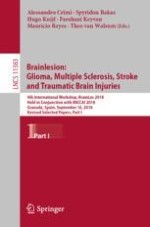2019 | OriginalPaper | Buchkapitel
Shallow vs Deep Learning Architectures for White Matter Lesion Segmentation in the Early Stages of Multiple Sclerosis
verfasst von : Francesco La Rosa, Mário João Fartaria, Tobias Kober, Jonas Richiardi, Cristina Granziera, Jean-Philippe Thiran, Meritxell Bach Cuadra
Erschienen in: Brainlesion: Glioma, Multiple Sclerosis, Stroke and Traumatic Brain Injuries
Aktivieren Sie unsere intelligente Suche, um passende Fachinhalte oder Patente zu finden.
Wählen Sie Textabschnitte aus um mit Künstlicher Intelligenz passenden Patente zu finden. powered by
Markieren Sie Textabschnitte, um KI-gestützt weitere passende Inhalte zu finden. powered by
